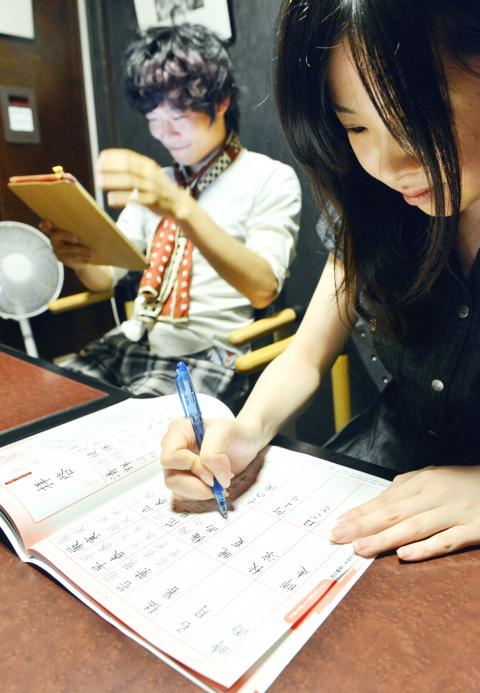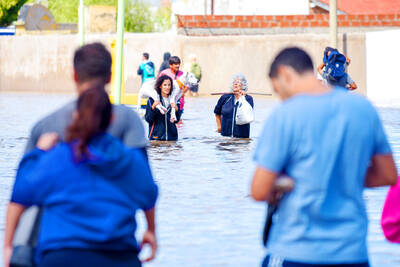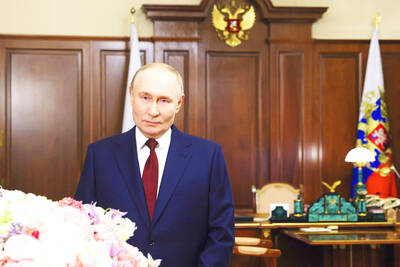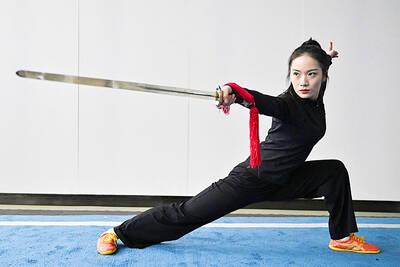As a schoolboy, Akihiro Matsumura spent hundreds of hours learning the intricate Chinese characters that make up a part of written Japanese. Now, the graduate student can rely on his smartphone, tablet and laptop to remember them for him.
“Sometimes I don’t even bother to take notes in seminars. I just take out my tablet to shoot pictures of what instructors write on blackboards,” he said.
Like millions of people across East Asia, 23-year-old Matsumura is forgetting the pictographs and ideographs that have been used in Japan and greater China for centuries.

Photo: AFP
While some bemoan what they see as the loss of history and culture, others say the shift frees up brainpower for more useful things, like foreign languages, and even improves writing as a whole.
Naoko Matsumoto, a professor of law who heads international legal studies at the prestigious Sophia University near Tokyo, said the students in her classes now write more fluently than their predecessors.
“I’m in my 40s and compared with my generation, they have more and more opportunities to write using Twitter” and other social networking services, she said.
“I think they are actually better at writing” because they write in a simple and easy-to-understand way, she said.
Priorities are changing with more emphasis placed on building logical thinking strategies — a case of content becoming more important than form.
“The skill of handwriting kanji [Chinese characters] perfectly is becoming less necessary compared with earlier times,” Matsumoto said.
Kanji developed in China as a mixture of pictographs — characters that represent a thing, like “mountain” — and ideographs — those that depict an abstract concept, like “think.”
Japan imported kanji some time during the first millennium to use as a writing system, despite there being no linguistic link between Japanese and Chinese.
By around the eighth to ninth century, it developed a syllabary — a system of consonant/vowel blends — called hiragana.
A second syllabary, called katakana, also developed. Modern-day written Japanese is a mixture of kanji, hiragana and katakana, with an increasing amount of Western script also thrown in (known as romaji or Roman letters).
In both Chinese and Japanese, computer and smartphone users need only to type the pronunciation of the kanji from the constituent sounds using either the syllabary or the alphabet. They then choose one of several options offered by the device.
“It’s easy to forget even the easiest of characters,” said Zhang Wentong, an assistant at a calligraphy center in Beijing.
“Sometimes you’ve got to think for ages. Occasionally I’ll repeatedly type the character out phonetically in my phone” until the right one pops up.
Graduate student Matsumura said his reliance on devices leaves him adrift when faced with filling in forms for repairs at the electronics shop where he works part-time.
“I sometimes can’t recall kanji on the spot while a customer is watching me,” he said. “I remember their rough shapes, but can’t remember exact strokes... It’s foggy.”
Traditionalists fear that forgetting kanji means the irrevocable loss of a fundamental part of culture.
In Hong Kong, Rebecca Ko said her 11-year-old daughter is spending more time on the computer, but she insists the child learn traditional characters and sends her to a Chinese calligraphy class.
“We cannot rely too much on computers, we should be able to write ... [and] we should be able to write neatly, it’s a basic thing about being Chinese,” she said.
However, for Matsumura, times change and the spread of technology gives people opportunities to develop their language capability in other ways, for example allowing some to read more.
“I’m one of them. I used to listen to music blankly on trains, but I now read news and other things,” he said.
Guardians of the characters say there is no evidence of any drop-off in enthusiasm. The Japan Kanji Aptitude Testing Foundation in Kyoto says the number of people who take its exam every year is holding steady at about 2 million.
People are “increasingly using text messages rather than making phone calls,” which means they need to know which characters to use, a spokeswoman said.
Yusuke Kinouchi, a 24-year-old graduate student at the Tokyo Institute of Technology, said kanji provide a certain economy, where one character can stand in for the sounds made by several letters in a language, such as English — something particularly useful on Twitter, for example, with its 140-character limit.
Moreover, “they [the characters] are beautiful,” he said.

ANGER: A video shared online showed residents in a neighborhood confronting the national security minister, attempting to drag her toward floodwaters Argentina’s port city of Bahia Blanca has been “destroyed” after being pummeled by a year’s worth of rain in a matter of hours, killing 13 and driving hundreds from their homes, authorities said on Saturday. Two young girls — reportedly aged four and one — were missing after possibly being swept away by floodwaters in the wake of Friday’s storm. The deluge left hospital rooms underwater, turned neighborhoods into islands and cut electricity to swaths of the city. Argentine Minister of National Security Patricia Bullrich said Bahia Blanca was “destroyed.” The death toll rose to 13 on Saturday, up from 10 on Friday, authorities

Local officials from Russia’s ruling party have caused controversy by presenting mothers of soldiers killed in Ukraine with gifts of meat grinders, an appliance widely used to describe Russia’s brutal tactics on the front line. The United Russia party in the northern Murmansk region posted photographs on social media showing officials smiling as they visited bereaved mothers with gifts of flowers and boxed meat grinders for International Women’s Day on Saturday, which is widely celebrated in Russia. The post included a message thanking the “dear moms” for their “strength of spirit and the love you put into bringing up your sons.” It

DEBT BREAK: Friedrich Merz has vowed to do ‘whatever it takes’ to free up more money for defense and infrastructure at a time of growing geopolitical uncertainty Germany’s likely next leader Friedrich Merz was set yesterday to defend his unprecedented plans to massively ramp up defense and infrastructure spending in the Bundestag as lawmakers begin debating the proposals. Merz unveiled the plans last week, vowing his center-right Christian Democratic Union (CDU)/Christian Social Union (CSU) bloc and the center-left Social Democratic Party (SPD) — in talks to form a coalition after last month’s elections — would quickly push them through before the end of the current legislature. Fraying Europe-US ties under US President Donald Trump have fueled calls for Germany, long dependent on the US security umbrella, to quickly

In front of a secluded temple in southwestern China, Duan Ruru skillfully executes a series of chops and strikes, practicing kung fu techniques she has spent a decade mastering. Chinese martial arts have long been considered a male-dominated sphere, but a cohort of Generation Z women like Duan is challenging that assumption and generating publicity for their particular school of kung fu. “Since I was little, I’ve had a love for martial arts... I thought that girls learning martial arts was super swaggy,” Duan, 23, said. The ancient Emei school where she trains in the mountains of China’s Sichuan Province